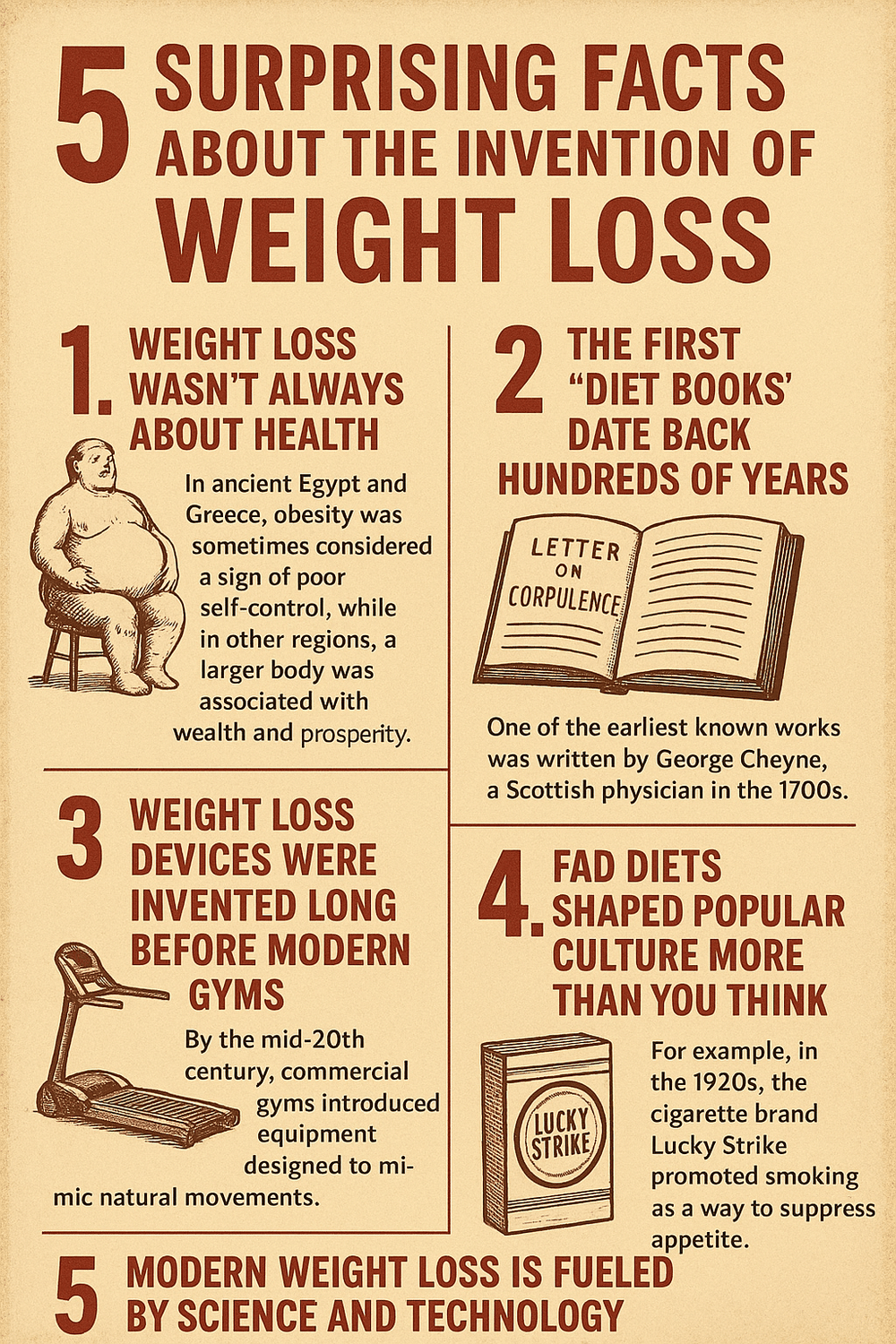Product Guide
5 Surprizing Facts About the Invention of the Weight Loss
When people hear the phrase “the invention of weight loss,” it often sparks curiosity. After all, weight loss isn’t a gadget or a scientific formula in itself—it’s a human practice, a cultural phenomenon, and in many ways, a social invention. From ancient remedies to modern technology, the pursuit of shedding extra pounds has been shaped by history, culture, and even science in ways you might not expect.
Here are five surprising facts about how the concept and practice of weight loss came to be—and how it continues to evolve.

1. Weight Loss Wasn’t Always About Health
Today, when we talk about weight loss, the conversation is usually centered on health benefits—lowering blood pressure, reducing diabetes risk, improving heart health, or simply feeling better in our own skin. But historically, weight loss wasn’t always associated with health at all.
In ancient societies, body size carried very different meanings depending on the culture. For example, in ancient Egypt and Greece, obesity was sometimes considered a sign of poor self-control, while in other regions, a larger body was associated with wealth and prosperity. Thinness, in contrast, was often a marker of poverty and scarcity.
It wasn’t until the 19th century that weight loss began to be linked directly with health and longevity. Physicians started documenting the risks of obesity, and by the early 20th century, weight loss became tied to medical advice. This shift marked the beginning of weight loss as not just a cosmetic preference, but a health practice.
2. The First “Diet Books” Date Back Hundreds of Years
You might think diet books are a modern phenomenon, filling bookstore shelves with catchy titles and quick fixes. But the first published guides to weight loss go back to the 17th and 18th centuries.
One of the earliest known works was written by George Cheyne, a Scottish physician in the 1700s. He suffered from obesity himself and documented how adopting a plant-based, milk-and-vegetable diet helped him lose weight and regain health. His writings became popular among European elites, making him one of the first “diet gurus.”
Later, in the 1860s, William Banting, an English undertaker, published a pamphlet titled Letter on Corpulence, Addressed to the Public. Banting shared how cutting bread, sugar, beer, and potatoes helped him lose a significant amount of weight. This pamphlet was so influential that people started using the word “banting” as a synonym for dieting—a term still recognized in some countries today.
These early diet books show that the invention of weight loss wasn’t about fads alone—it was about personal experience transformed into advice, something still common in today’s wellness industry.
3. Weight Loss Devices Were Invented Long Before Modern Gyms
When we think of weight loss tools today, high-tech fitness trackers and modern gyms come to mind. But inventors were already creating strange and surprising devices for weight loss more than a century ago.
In the late 19th and early 20th centuries, advertisements promoted machines like “vibrating belts,” “rolling massagers,” and “electric slimming devices.” These contraptions claimed to jiggle fat away or stimulate muscle contraction without effort. Although most were ineffective, they highlight how early inventors tried to make weight loss effortless and mechanical.
By the mid-20th century, commercial gyms started introducing equipment designed to mimic natural movements, like treadmills and resistance machines. Interestingly, the treadmill was originally designed as a punishment device for prisoners in the 1800s—a way to make inmates walk endlessly while grinding grain or pumping water. Eventually, the treadmill was repurposed into a fitness tool and became a staple for weight management worldwide.
These devices show how innovation and the dream of “easy weight loss” have always gone hand in hand.
Lorem ipsum dolor sit amet, consectetur adipisicing elit. Autem dolore, alias, numquam enim ab voluptate id quam harum ducimus cupiditate similique quisquam et deserunt, recusandae.
4. Fad Diets Shaped Popular Culture More Than You Think
Another surprising fact about the invention of weight loss is how fad diets influenced culture, fashion, and even language.
For example, in the 1920s, the cigarette brand Lucky Strike promoted smoking as a way to suppress appetite with the slogan, “Reach for a Lucky instead of a sweet.” While harmful and misleading, it shows how deeply weight loss culture had embedded itself into advertising.
Later, in the 1980s, the rise of low-fat diets changed not just how people ate, but how companies produced food. Grocery store shelves became filled with fat-free cookies, chips, and snacks—many of which were marketed as “diet-friendly” despite being packed with sugar.
These fads weren’t always scientifically sound, but they reveal how the invention of weight loss as a social phenomenon shaped entire industries. From publishing and fashion to food and fitness, the desire to lose weight created markets worth billions of dollars.

5. Modern Weight Loss Is Fueled by Science and Technology
Perhaps the most fascinating fact is how weight loss today has evolved into a field powered by science and technology. Unlike the vibrating belts or the fad diets of the past, modern strategies often have evidence to back them up.
For instance, medical research now shows the effectiveness of balanced nutrition, exercise, and sleep on long-term weight management. Technology has also changed the way people lose weight—apps can track calorie intake, wearable devices can monitor activity levels, and AI-powered platforms can offer personalized coaching.
In medicine, treatments like bariatric surgery and new weight-loss medications (such as GLP-1 receptor agonists) are transforming the way doctors help patients struggling with obesity. These advancements represent a significant shift: weight loss is no longer just a matter of willpower but is seen as a complex interaction of biology, psychology, and lifestyle.
This scientific approach may be the most important “invention” of all—one that helps people pursue weight loss with greater understanding and support.
Conclusion: The Ongoing Invention of Weight Loss
The story of weight loss isn’t about a single invention—it’s about the evolution of an idea. From early diet books and strange slimming machines to modern science and personalized health plans, weight loss has been “reinvented” time and again.
What’s surprising is how weight loss has always reflected the culture of its time. Whether as a symbol of health, wealth, or beauty, the desire to lose weight has shaped everything from publishing to advertising to medicine. Today, weight loss continues to evolve, blending technology, psychology, and biology into a more holistic approach.
The invention of weight loss is not finished—it’s ongoing, constantly adapting as our understanding of the human body deepens. And while fads may come and go, one truth remains: the pursuit of better health and confidence is timeless.
HEY, I’M AUTHOR…
Platform for Health, Electronics, Home & Kitchen, Clothing etc related News. We are determined to bring you the scoop of the media and latest trends here everyday, round the clock.
JOIN MY MAILING LIST
Created with © systeme.io


